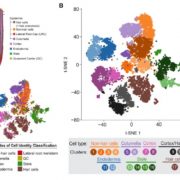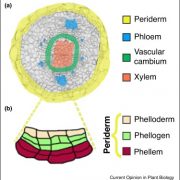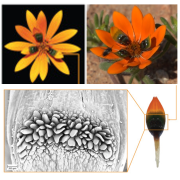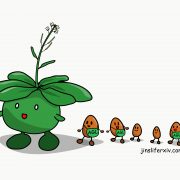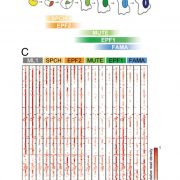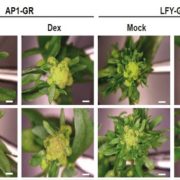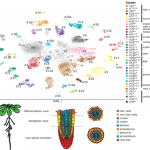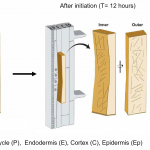Cell-by-cell dissection of phloem development links a maturation gradient to cell specialization (Science)
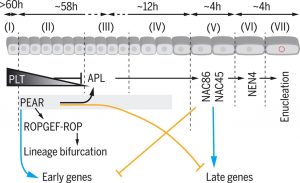 In this seminal paper, Roszak et al. present a deeper understanding of the development of the protophloem cell lineage. The differentiation process from the phloem stem cell to the enucleated cell state spans approximately 19 cells. Using live imaging, FACS sorting and single-cell RNA sequencing, the authors gain information about the transcriptomes of these cells and show that they can be grouped into seven distinct developmental stages. Interestingly, progression through these stages is associated with sharp transcriptomic changes realized through gene regulatory networks with mutual inhibition modules. The linage bifurcation of metaphloem and procambium cell files, taking place in stage II, depends on lineage-specific PHLOEM EARLY DNA-BINDING-WITH-ONE-FINGER (PEAR) transcription factors that activate distinct ROPGEF-ROP signaling to control asymmetric cell divisions. The transition from cell division to cell differentiation (stage II to IV) is dependent on a PLETHORA protein gradient directly repressing ALTERED PHLOEM DEVELOPMENT (APL) which functions in promoting cell maturation. In contrast, PEAR transcription factors promote phloem differentiation through activation of APL, initiating early differentiation. By functionally analyzing the interplay of key transcription factors, this paper provides a detailed understanding of developmental transitions and maturation processes in phloem development. (Summary by Aylin S Haas @AylinHaas_) Science 10.1126/science.aba5531
In this seminal paper, Roszak et al. present a deeper understanding of the development of the protophloem cell lineage. The differentiation process from the phloem stem cell to the enucleated cell state spans approximately 19 cells. Using live imaging, FACS sorting and single-cell RNA sequencing, the authors gain information about the transcriptomes of these cells and show that they can be grouped into seven distinct developmental stages. Interestingly, progression through these stages is associated with sharp transcriptomic changes realized through gene regulatory networks with mutual inhibition modules. The linage bifurcation of metaphloem and procambium cell files, taking place in stage II, depends on lineage-specific PHLOEM EARLY DNA-BINDING-WITH-ONE-FINGER (PEAR) transcription factors that activate distinct ROPGEF-ROP signaling to control asymmetric cell divisions. The transition from cell division to cell differentiation (stage II to IV) is dependent on a PLETHORA protein gradient directly repressing ALTERED PHLOEM DEVELOPMENT (APL) which functions in promoting cell maturation. In contrast, PEAR transcription factors promote phloem differentiation through activation of APL, initiating early differentiation. By functionally analyzing the interplay of key transcription factors, this paper provides a detailed understanding of developmental transitions and maturation processes in phloem development. (Summary by Aylin S Haas @AylinHaas_) Science 10.1126/science.aba5531


